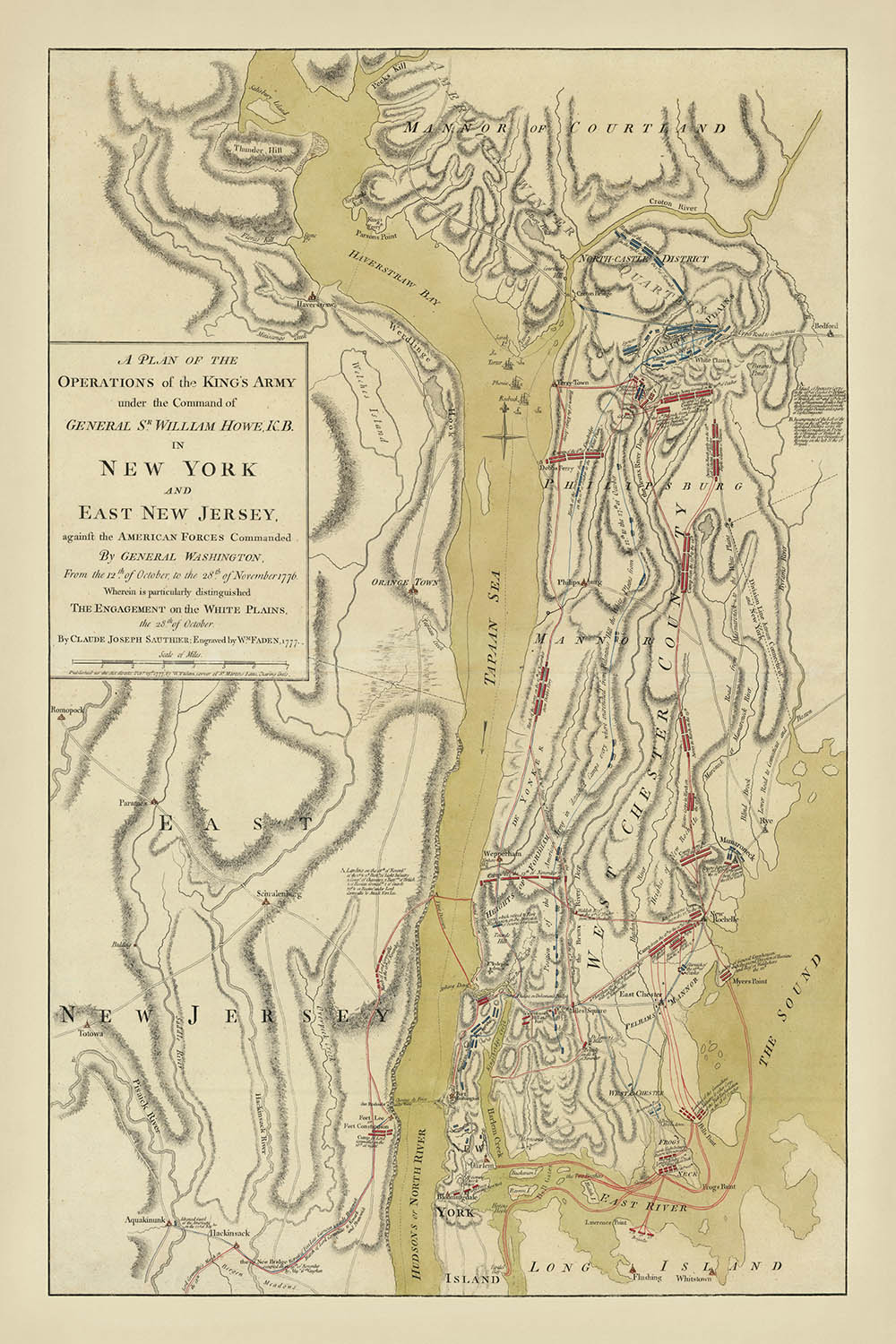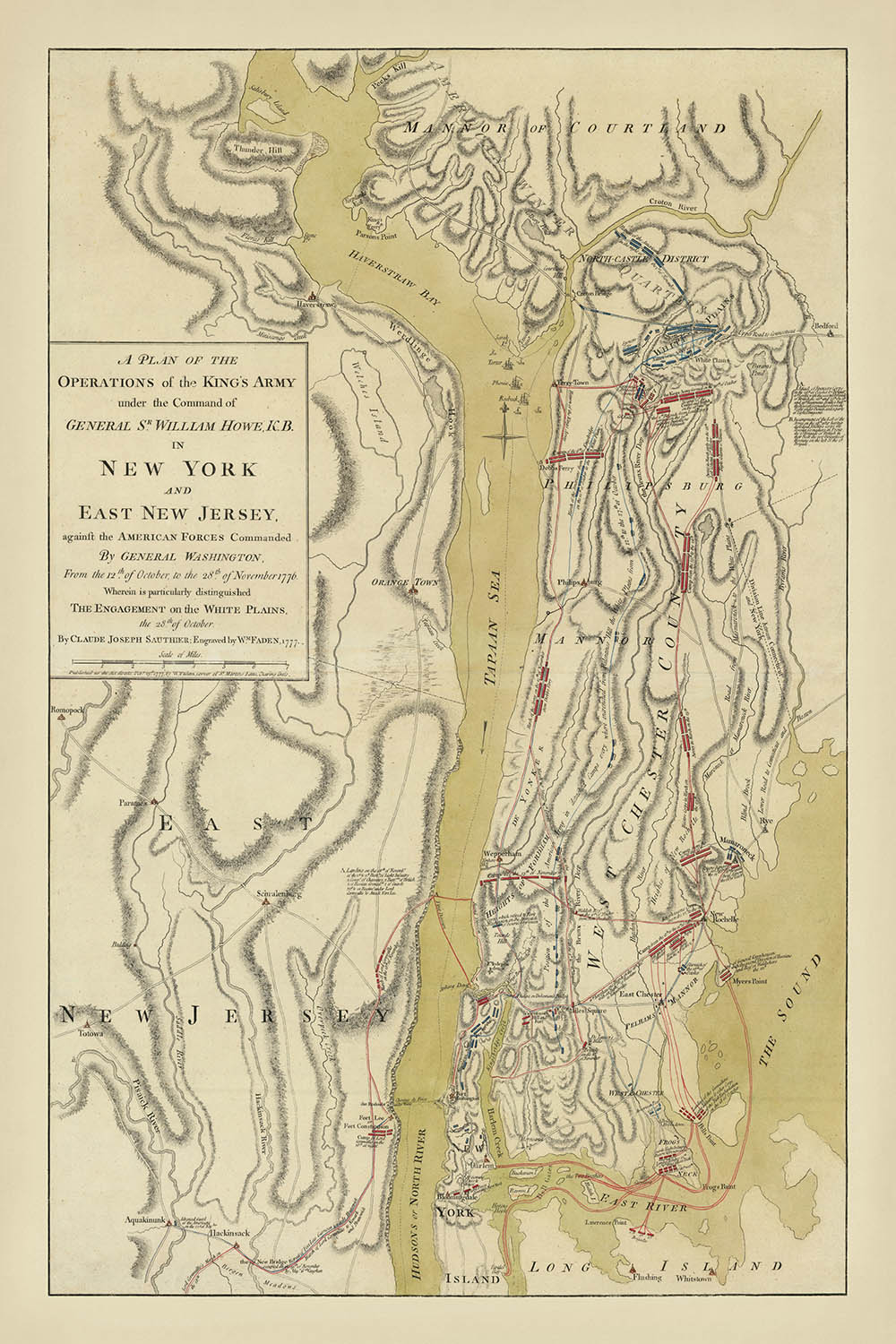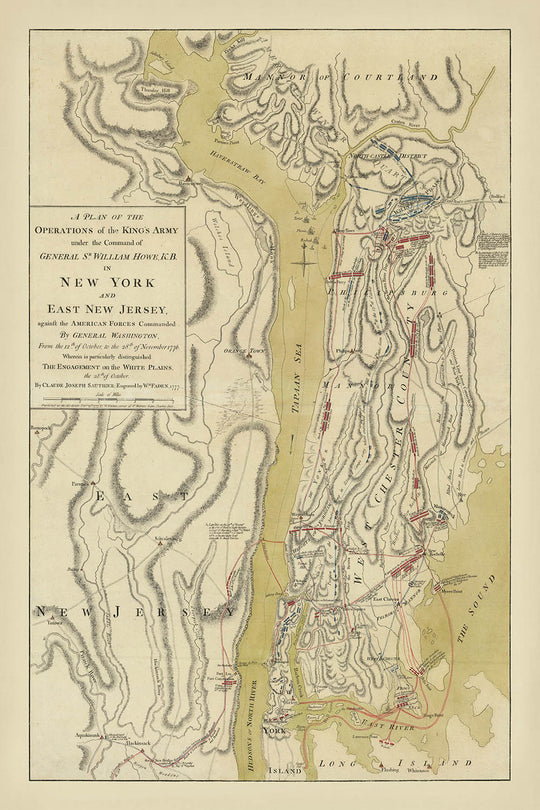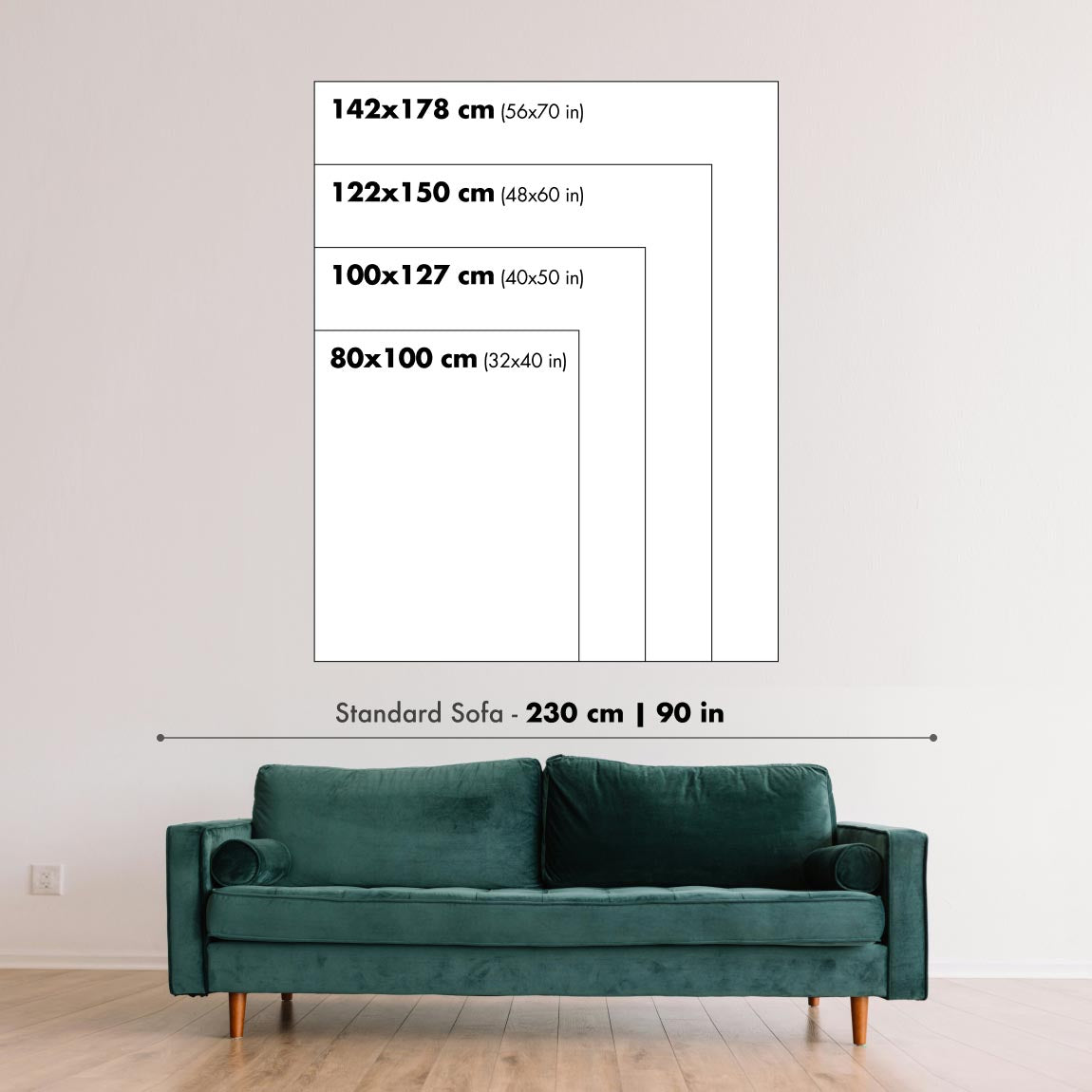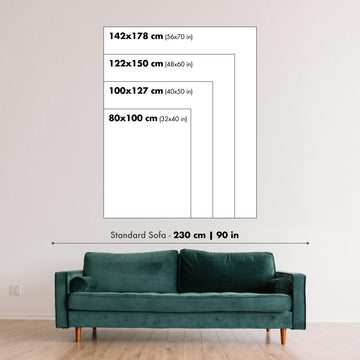- Handmade locally. No import duty or tax
- FREE worldwide delivery
- Love it or your money back (90 days)
- Questions? WhatsApp me any time
Own a piece of history
5,000+ 5 star reviews


Step back in time to the pivotal moments of the American Revolutionary War with this meticulously detailed map, "A Plan of the Operations of the King's Army under the Command of General Sr. William Howe, K.B. in New York and East New Jersey, against the American Forces Commanded By General Washington, From the 12th of October to the 28th of November 1776." Created by the esteemed cartographer William Faden in 1777, this map offers a vivid depiction of the strategic maneuvers and engagements between British and American forces. It is a testament to the cartographic precision and historical significance of the era, capturing the essence of the military campaigns that shaped the early course of the American Revolution.
The map is particularly notable for its detailed representation of the Battle of White Plains, an early and crucial test of General George Washington's leadership. The American forces, shown in blue, and the British troops, depicted in red, are meticulously tracked, illustrating both troop movements and fixed positions. This map highlights the strategic retreat of Washington's forces to Westchester after their defeat on Manhattan Island, showcasing the resilience and tactical acumen of the American commander. The British pursuit, aiming to crush the American army and end the war, is vividly brought to life through Faden's precise delineation.
William Faden's work is renowned for its accuracy and detail, and this map is no exception. It was drawn from the observations of British military engineer Claude Joseph Sauthier, who participated in the campaigns. The map not only illustrates the movements of the armies but also provides insights into the complex amphibious landings by British forces in the Bronx and Westchester. The inclusion of additional place names and the depiction of five ships off Enoch Point and Sarak Island add to the map's rich historical context, making it an invaluable resource for understanding the intricacies of the New York campaign.
The regions depicted on the map include northern Manhattan, lower Westchester, and parts of East New Jersey, with notable locations such as Fort Washington, Fort Lee, and the strategically significant Chatterton Hill. The map also shows the landing sites of British and Hessian troops, as well as key villages and towns like Mamaroneck, Larchmont, New Rochelle, and Pelham Manor. These details provide a comprehensive view of the theater of operations, highlighting the geographical challenges and strategic considerations faced by both sides during the campaign.
This historically informative map is more than just a visual representation of military maneuvers; it is a window into a critical period of the American Revolution. It captures the tension, strategy, and resilience of the American forces under General Washington's command. The Battle of White Plains, while a tactical victory for the British, ultimately proved to be a strategic success for the Americans, showcasing their ability to adapt and endure. This map is a tribute to the enduring spirit of the American Revolution and a valuable addition to any collection of historical artifacts.
Places on this map
- New York City
- Long Island
- White Plains
- Bronx
- Westchester County
- Mamaroneck
- Larchmont
- New Rochelle
- Pelham Manor
- Fort Washington
- Fort Lee
- Haverstraw Bay
- Tappan Sea
- Croton River
- Orange Town
- Aquakanunk
- Hackinsack
- Thunder Hill
- Pines Bridge
- Sarak Island
Notable Features & Landmarks
- British troop positions and movements (in red)
- American troop positions and movements (in blue)
- Landing sites of British and Hessian troops
- Strategic locations such as Chatterton Hill
- Hudson River and East River
- Tartar, Phenix, and Roebuck ships off Enoch Point and Sarak Island
- The main line of American resistance along a ridge near White Plains
- Cornwallis' capture of Fort Lee
- Washington's retreat routes
- British and Hessian forces' positions during the Battle of White Plains
- Amphibious landings by British forces in the Bronx and Westchester
- Locations of key engagements and skirmishes
- Strategically significant elevations and hills
- Roads and trails used by the armies
- Positions of artillery and fortifications
- Manor of Courtland and Manor of Scarsdale
- The Sound and the Tappan Sea
Historical and design context
- Name of the map: A Plan of the Operations of the King's Army under the Command of General Sr. William Howe, K.B. in New York and East New Jersey, against the American Forces Commanded By General Washington, From the 12th of October to the 28th of November 1776
- Creation date: 1777
- Mapmaker or publisher: William Faden
- Military operations: Details the movements and positions of British and American forces during the New York campaign of 1776
- Battle of White Plains: Focuses particularly on the Battle of White Plains, an early test of General George Washington's command
- Troop movements: British troops (in red) and American forces (in blue) are meticulously tracked, showing both fixed positions and movements
- Amphibious landings: Shows complex amphibious landings by British forces in the Bronx and Westchester
- Regions shown on the map: Northern Manhattan, lower Westchester, and parts of East New Jersey
- Original hand-color: Features original hand-coloring to distinguish British and American forces
- Detailed delineation: Noted for its accuracy and detail in depicting the movements and positions of the armies
- American Revolutionary War: Illustrates an important early battle during the American Revolution
- Strategic retreat: Shows the American army's retreat to Westchester after their defeat on Manhattan Island
- British pursuit: Details the British forces' pursuit of the American army, aiming to crush them and end the war
- Washington's leadership: Showcases General George Washington's leadership and the resilience of the American troops
Please double check the images to make sure that a specific town or place is shown on this map. You can also get in touch and ask us to check the map for you.
This map looks great at every size, but I always recommend going for a larger size if you have space. That way you can easily make out all of the details.
This map looks amazing at sizes all the way up to 100in (250cm). If you are looking for a larger map, please get in touch.
Please note: the labels on this map are hard to read if you order a map that is 20in (50cm) or smaller. The map is still very attractive, but if you would like to read the map easily, please buy a larger size.
The model in the listing images is holding the 24x36in (60x90cm) version of this map.
The fifth listing image shows an example of my map personalisation service.
If you’re looking for something slightly different, check out my collection of the best old maps to see if something else catches your eye.
Please contact me to check if a certain location, landmark or feature is shown on this map.
This would make a wonderful birthday, Christmas, Father's Day, work leaving, anniversary or housewarming gift for someone from the areas covered by this map.
This map is available as a giclée print on acid free archival matte paper, or you can buy it framed. The frame is a nice, simple black frame that suits most aesthetics. Please get in touch if you'd like a different frame colour or material. My frames are glazed with super-clear museum-grade acrylic (perspex/acrylite), which is significantly less reflective than glass, safer, and will always arrive in perfect condition.
This map is also available as a float framed canvas, sometimes known as a shadow gap framed canvas or canvas floater. The map is printed on artist's cotton canvas and then stretched over a handmade box frame. We then "float" the canvas inside a wooden frame, which is available in a range of colours (black, dark brown, oak, antique gold and white). This is a wonderful way to present a map without glazing in front. See some examples of float framed canvas maps and explore the differences between my different finishes.
For something truly unique, this map is also available in "Unique 3D", our trademarked process that dramatically transforms the map so that it has a wonderful sense of depth. We combine the original map with detailed topography and elevation data, so that mountains and the terrain really "pop". For more info and examples of 3D maps, check my Unique 3D page.
For most orders, delivery time is about 3 working days. Personalised and customised products take longer, as I have to do the personalisation and send it to you for approval, which usually takes 1 or 2 days.
Please note that very large framed orders usually take longer to make and deliver.
If you need your order to arrive by a certain date, please contact me before you order so that we can find the best way of making sure you get your order in time.
I print and frame maps and artwork in 23 countries around the world. This means your order will be made locally, which cuts down on delivery time and ensures that it won't be damaged during delivery. You'll never pay customs or import duty, and we'll put less CO2 into the air.
All of my maps and art prints are well packaged and sent in a rugged tube if unframed, or surrounded by foam if framed.
I try to send out all orders within 1 or 2 days of receiving your order, though some products (like face masks, mugs and tote bags) can take longer to make.
If you select Express Delivery at checkout your order we will prioritise your order and send it out by 1-day courier (Fedex, DHL, UPS, Parcelforce).
Next Day delivery is also available in some countries (US, UK, Singapore, UAE) but please try to order early in the day so that we can get it sent out on time.
My standard frame is a gallery style black ash hardwood frame. It is simple and quite modern looking. My standard frame is around 20mm (0.8in) wide.
I use super-clear acrylic (perspex/acrylite) for the frame glass. It's lighter and safer than glass - and it looks better, as the reflectivity is lower.
Six standard frame colours are available for free (black, dark brown, dark grey, oak, white and antique gold). Custom framing and mounting/matting is available if you're looking for something else.
Most maps, art and illustrations are also available as a framed canvas. We use matte (not shiny) cotton canvas, stretch it over a sustainably sourced box wood frame, and then 'float' the piece within a wood frame. The end result is quite beautiful, and there's no glazing to get in the way.
All frames are provided "ready to hang", with either a string or brackets on the back. Very large frames will have heavy duty hanging plates and/or a mounting baton. If you have any questions, please get in touch.
See some examples of my framed maps and framed canvas maps.
Alternatively, I can also supply old maps and artwork on canvas, foam board, cotton rag and other materials.
If you want to frame your map or artwork yourself, please read my size guide first.
My maps are extremely high quality reproductions of original maps.
I source original, rare maps from libraries, auction houses and private collections around the world, restore them at my London workshop, and then use specialist giclée inks and printers to create beautiful maps that look even better than the original.
My maps are printed on acid-free archival matte (not glossy) paper that feels very high quality and almost like card. In technical terms the paper weight/thickness is 10mil/200gsm. It's perfect for framing.
I print with Epson ultrachrome giclée UV fade resistant pigment inks - some of the best inks you can find.
I can also make maps on canvas, cotton rag and other exotic materials.
Learn more about The Unique Maps Co.
Map personalisation
If you're looking for the perfect anniversary or housewarming gift, I can personalise your map to make it truly unique. For example, I can add a short message, or highlight an important location, or add your family's coat of arms.
The options are almost infinite. Please see my map personalisation page for some wonderful examples of what's possible.
To order a personalised map, select "personalise your map" before adding it to your basket.
Get in touch if you're looking for more complex customisations and personalisations.
Map ageing
I have been asked hundreds of times over the years by customers if they could buy a map that looks even older.
Well, now you can, by selecting Aged before you add a map to your basket.
All the product photos you see on this page show the map in its Original form. This is what the map looks like today.
If you select Aged, I will age your map by hand, using a special and unique process developed through years of studying old maps, talking to researchers to understand the chemistry of aging paper, and of course... lots of practice!
If you're unsure, stick to the Original colour of the map. If you want something a bit darker and older looking, go for Aged.
If you are not happy with your order for any reason, contact me and I'll get it fixed ASAP, free of charge. Please see my returns and refund policy for more information.
I am very confident you will like your restored map or art print. I have been doing this since 1984. I'm a 5-star Etsy seller. I have sold tens of thousands of maps and art prints and have over 5,000 real 5-star reviews. My work has been featured in interior design magazines, on the BBC, and on the walls of dozens of 5-star hotels.
I use a unique process to restore maps and artwork that is massively time consuming and labour intensive. Hunting down the original maps and illustrations can take months. I use state of the art and eye-wateringly expensive technology to scan and restore them. As a result, I guarantee my maps and art prints are a cut above the rest. I stand by my products and will always make sure you're 100% happy with what you receive.
Almost all of my maps and art prints look amazing at large sizes (200cm, 6.5ft+) and I can frame and deliver them to you as well, via special oversized courier. Contact me to discuss your specific needs.
Or try searching for something!







